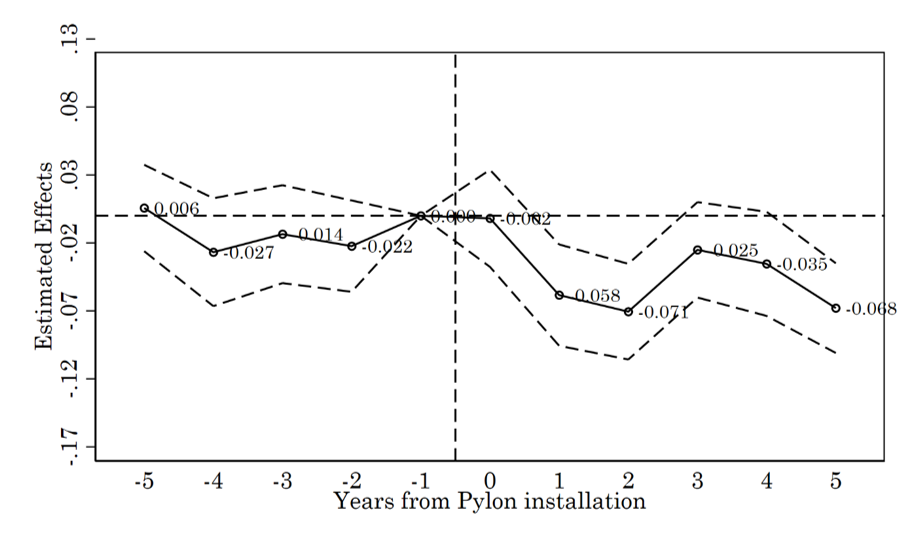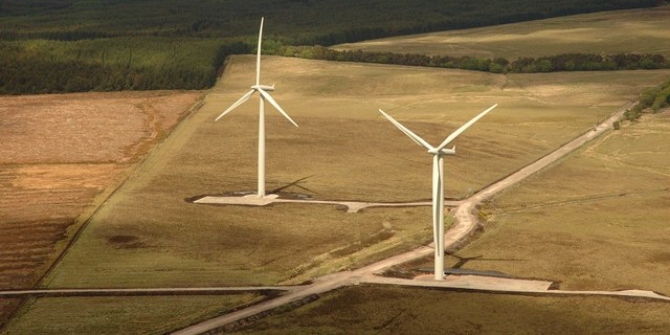The transition to green energy requires many new electrical power lines to be constructed. In the UK, this construction is a contentious planning and political issue. Steve Gibbons and Cheng Keat Tang show the local costs of this infrastructure, by comparing house price changes before and after construction of pylons in nearby neighbourhoods, with those further away.
High voltage overhead power lines and their associated pylons are ubiquitous features of developed countries and provide an essential role in cost-effective electricity transmission. They have, nevertheless, long raised objections from those concerned about their effect on the landscape. John Maynard Keynes and Rudyard Kipling reportedly wrote to the Times newspaper in the late 1920s when the national electrical grid was first developed in Britain, describing the impact of pylons on the Sussex downs as “the permanent disfigurement of a familiar feature of the English landscape”. More recently, the risks of electromagnetic fields on health and of noise pollution have caused additional concerns.
These issues are once again salient and back in the news because of the need for new high voltage lines to connect sources of renewable energy to the grid, both in the UK and US. Construction of lines in the UK is inevitably stalled by planning objections and the Electricity Networks Commissioner has recently recommended monetary payments to households in their path, to speed up the process. Other organisations advocate burying cables underground to avoid their environmental effects, which is much more costly than running them overhead. Good estimates of the magnitude and spatial extent of the perceived environmental cost of power lines to local residents are therefore crucial, both for those affected by new power lines and for those planning their construction.
Our new research investigates these environmental effects by estimating households’ “willingness to pay” to avoid living near electricity pylons, as revealed through the effect of new pylons on the sales prices of houses nearby. The effects are larger and more widespread than has been found in previous research. Houses within 300 metres of new pylons sell for 10 per cent less, on average, than those more than over 1.5km away after pylon construction. Their influence decays with distance but can be detected up to about 1.2km. On average, houses sell for around 3.6 per cent less within 1.2km than beyond that distance after pylons are installed – see Figure 1. The implied cost is about £6000 per household in 2015 prices, around the end of our study period (about £7800 in 2023 prices).
Figure 1. Effect of pylon construction on house prices, within 1.2km, compared to beyond 1.5 km. To interpret the numbers, -0.02 means a 2% reduction, -0.03 a 3% reduction, etc.

Source: CEP discussion paper 1942 “Are friends electric? Valuing the social costs of power lines using house prices”.
Our estimates have important implications, given the need to run new lines to connect to new sources of renewable energy. The figures are relevant in determining compensation payments to households affected by new transmission lines and in evaluating the benefits of running cables underground. Our results imply compensation figures that are larger than those currently applied in the UK. As of now, only home-owners whose properties are crossed by power lines are compensated, but our analysis shows that the pylons imply costs on households that extend over a much larger area. A rough estimate of the average number of households within 1.2km of a 1km stretch of transmission line in England is 400 (an area of 2.4km squared, multiplied by the average household density of 170 per km squared). Based on our estimates, the cost to these local households from the environmental impacts of 1km of overhead lines in an area of average population density is around £2.5 million. The figures – and implied compensation payments to local communities – will be higher when density is higher, and lower when density is lower, as the number of people affected varies.
An alternative to providing compensation to households, is to bury cables underground. In the UK, the construction and maintenance cost associated with running electricity lines overhead was £2.2-4.2 million per km over their lifetime compared to £10.2-24.1 million per km for burying them underground in 2012, toward the end of our study period. The direct construction cost difference is therefore around £8-20 million per km. On average then, the benefits to households of burying the cables is significantly lower than the additional construction costs. In densely populated areas, burying cables is more likely to be justified (in line with current practice).
Unfortunately, this analysis has limitations when working out the monetary costs of installing pylons in remote rural locations and places of great natural beauty where nobody lives – and where compensation is not a relevant policy. The fact that pylons are disliked by residents means they are almost certainly disliked by anyone visiting an area, but we cannot say to what extent costs vary without assumptions about the numbers of visitors, length of visit or the natural amenities provided by the landscape. The visual damage in these settings may well exceed the mean cost to residential households which we provide in this study and could justify the costs of burying cables underground.
Technical note
Existing literature on this topic is based on relatively small samples, looks at very specific cases and/or simply looks at the cross-sectional differences in prices between houses close by and those further away. Ours is the first study to use a large representative sample of housing transactions to look at the changes caused by the construction of new pylons. We use all housing transactions in England and Wales and look at all new 400kV and 235kV lines constructed between 1995 and 2017 on the National Grid network. This ‘difference in difference’ method implies we are comparing the price changes occurring close to a pylon when it is constructed, with the price changes occurring at the same time further away. Figure 2, shows how these price changes decline with distance to pylons using our methodology (DID), compared with what we find using a simple cross-sectional comparison which reveals no price effects.
Figure 2. Effects of pylons on house prices at different distances. Effects of new pylons on price changes labelled as DID.

Source: CEP discussion paper 1942 “Are friends electric? Valuing the social costs of power lines using house prices”.
- This blog post is based on Are friends electric? Valuing the social costs of power lines using house prices, CEP discussion paper 1942.
- The post represents the views of its authors, not the position of LSE Business Review or the London School of Economics.
- Featured image provided by Shutterstock
- When you leave a comment, you’re agreeing to our Comment Policy.





